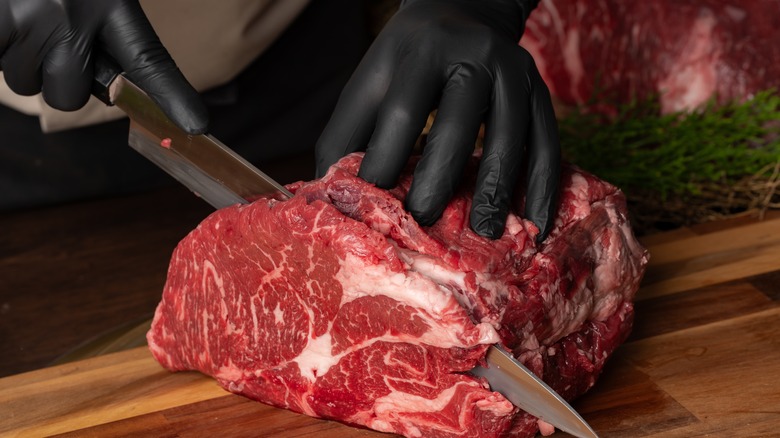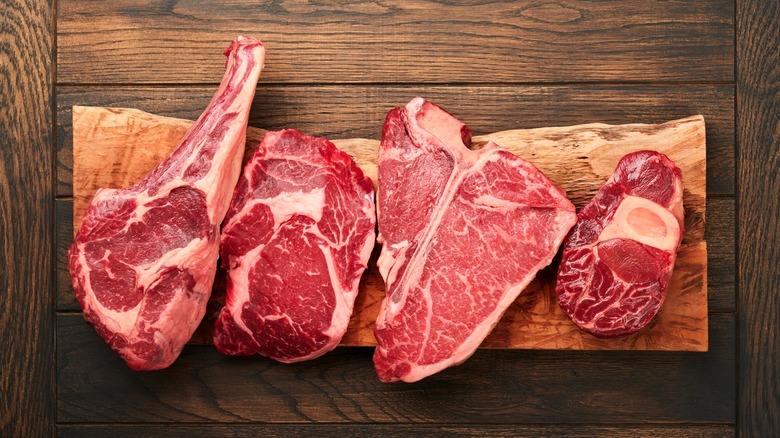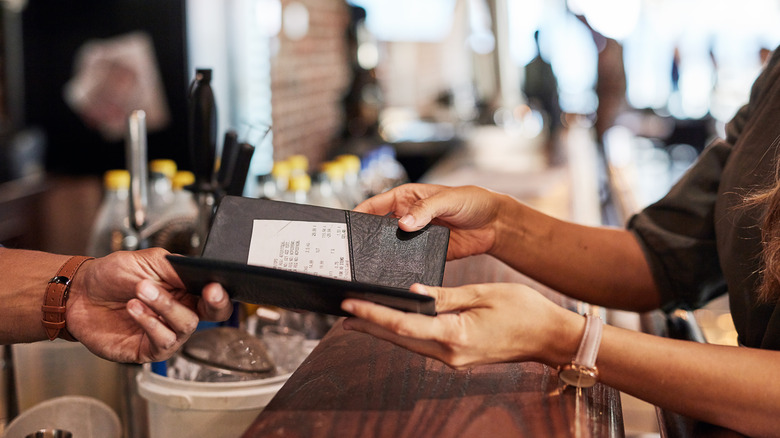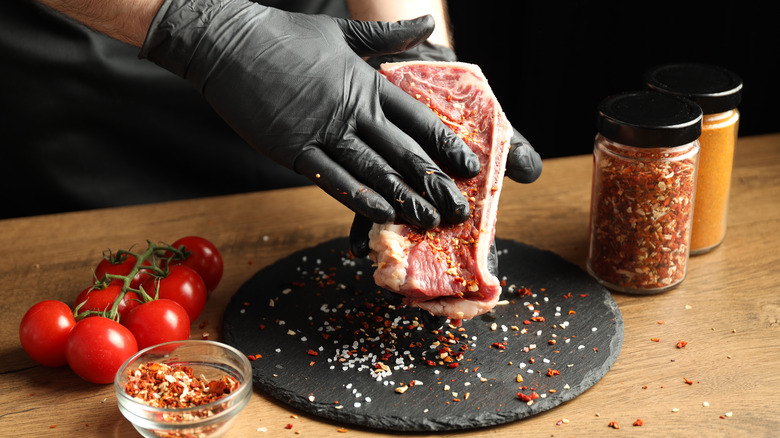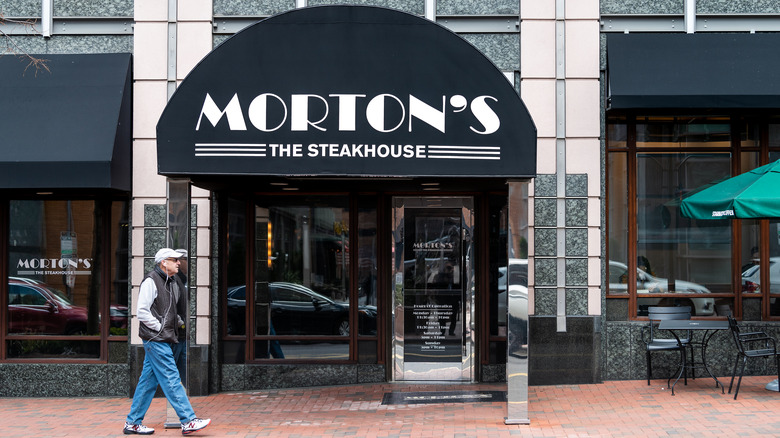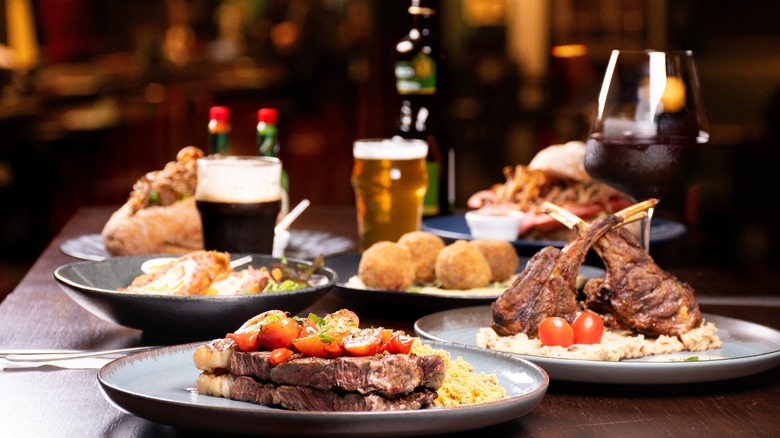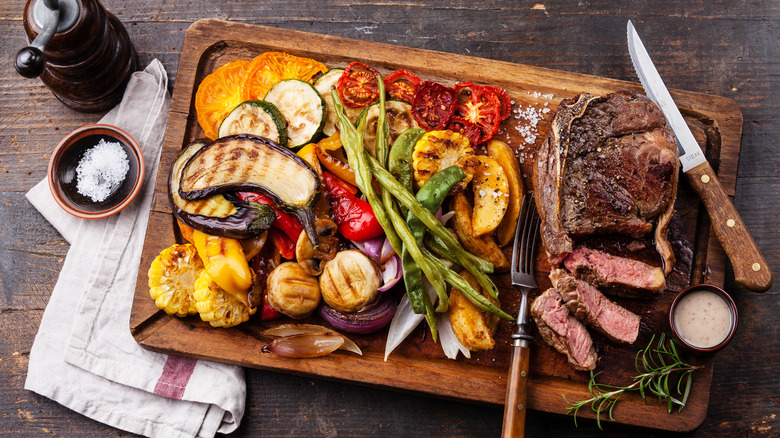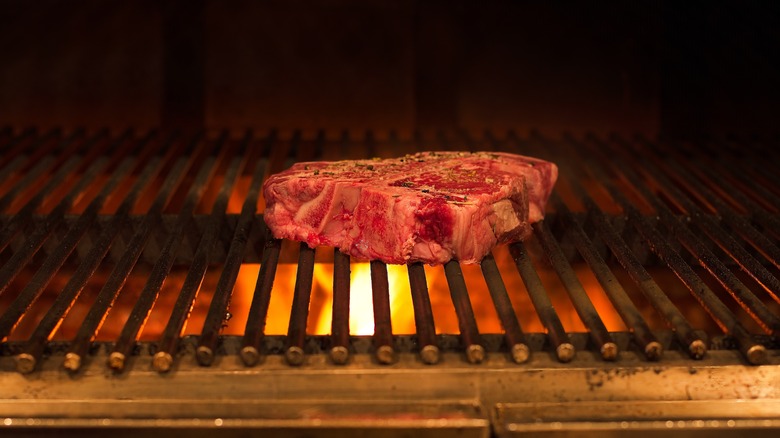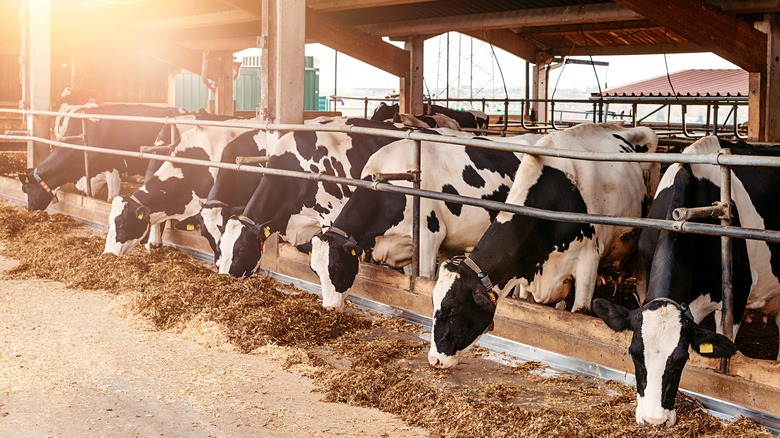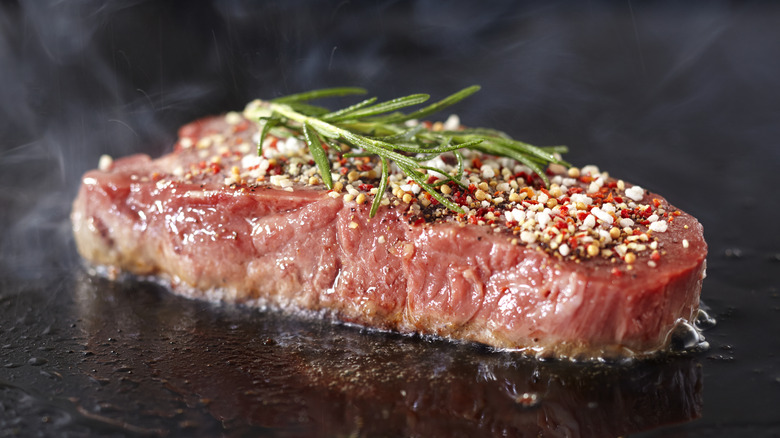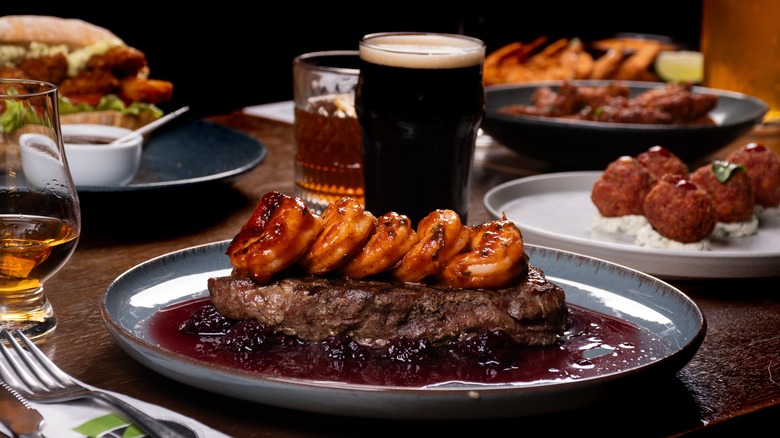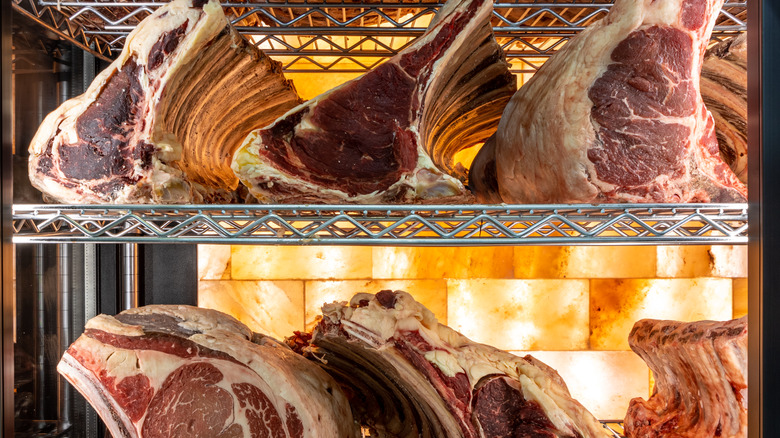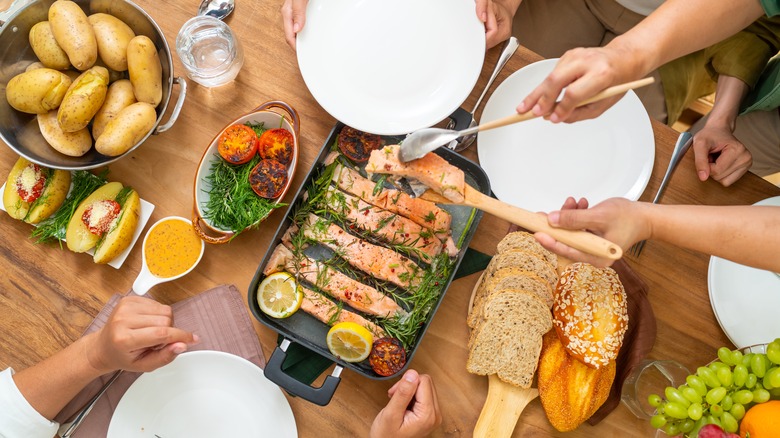13 Steakhouse Secrets You Won't Find On The Menu, According To Chefs
Steakhouses aren't just restaurants for Americans, they're culinary institutions associated with celebrating the finer things in life. From the fine-dining air of a high-end steakhouse to the homely interior of a neighborhood joint, there's nothing like a steakhouse for great cuts of meat. Home cooks and meat enthusiasts will often try to replicate the steak's flavors at home, but some cooking techniques have become trade secrets, such as getting a seared outer crust or the perfect shade of pink for a medium rare steak.
However, not all steakhouse secrets should stay hidden. Mashed reached out to experts from independent and chain steakhouses to get their intel on little-known information about steakhouse operations. For example, did you know there's an ideal time to visit steakhouses for the best experience? Or that premium steak is often not the USDA Prime it's advertised to be?
Three chefs from across the country, plus two industry experts, disclosed some of the secrets of the steakhouse trade, from where the meat really comes from to how some items are priced. Below, you'll find their steakhouse expertise laid out for the taking, the facts you won't find on the menu.
1. Some steakhouses source meat wholesale, while others rely on local suppliers
When picking out a steakhouse for dinner, you're probably gravitating towards places with the biggest and juiciest cuts, as well as the most accurate doneness. Add another item to the checklist: sourcing, aka, where does your meat come from? "
Almost 20 years ago, meat purveyors were independent and every city had its own great steak provider," says Izzy Kharasch, a seasoned hospitality consultant. "Today most of those companies have been bought out and are owned by Sysco, USFoods, etc." He adds that chefs will often work with these wholesale distributors to specify the cuts of meat they want, and try them out in test kitchens before making an order.
Although this practice might ring true for your neighborhood chain steakhouse, there are also many places that work with a local butcher shop or a regional supplier to source their cuts. Chef Paul Niedermann of the Jupiter Grill in Florida says all the meat for his steakhouse is sourced from northern Georgia or Iowa, to ensure only Prime and certified Angus beef is used. Similarly, Chef Carlos Barroz of Palermo, an Argentinian steakhouse in New York City, looks to decades-old local meat shops in the area such as the Piccinini Brothers or Esposito Meat Market for cuts.
2. Your steak's grade isn't guaranteed Prime, so make sure to ask your server
After determining your steak's source, the next step is to focus on its grade. The United States Department of Agriculture (USDA) assigns grades to beef, with Prime being the most coveted due to its abundant marbling. But even if a steak is labelled Prime on the menu, it's important to do your research and determine which cut you're actually being served. Chef Niedermann urges customers to inquire about their beef's grade, as some places may serve a lower grade than advertised. A "Prime" cut, for example, could actually be "Choice," a lower grade with less marbling.
Of course, if you're not overpaying for it, "Choice" can also be a good option, according to Chef Brad Wise, owner of Trust Restaurant Group in San Diego and Rare Society steakhouse. "There's a narrative out there that prime is the only option, but it's really not in my eyes", Wise says, adding that his steakhouse serves a lot of higher quality cuts of Choice beef. "Incorporating choice allows us to be a more approachable concept."
Problems with labeling also exist outside of beef grades, as Chef Barroz mentions. "Most common labeling such as 'Product of USA' could just mean it was finalized here, but doesn't provide much insight on where the animal was raised," he says. Inquiring about your steak grades may seem like an extra step, but it can help familiarize you with the meat and flavor better, adding value to the overall steakhouse experience.
3. Premium steak pricing depends on a lot more than meat quality
A night out at a high-end steak restaurant can leave you with a full stomach and a lighter wallet than when you walked in. It's natural to wonder why steak is so expensive, especially for those of us prone to indulging in this carnivorous feast. Chef Niedermann tells us that one of the biggest misconception consumers have with steaks is that "Price = Quality". Paying top dollar doesn't guarantee the steak's quality. Rather, the expertise of an entire kitchen staff comes into play and can make even a lesser cut shine.
Still, if you're opting for a Prime steak, expect a high price tag. Only 2%-3% of cuts in a cow are Prime grade, and they have to come from a young, well-fed cow, so the low quantity drives up the price, says Benjamin Prelvukaj, Founder and CEO of Benjamin Restaurant Group in Manhattan, which includes Benjamin Steakhouse.
Scarcity, and supply and demand are all big determining factors in the price tag, according to Chef Barroz. "Lower supplies often translate to higher prices. For example, tenderloin or filet mignon are naturally rarer, since the cut comes from an animal with less meat." Meanwhile, the demand for popular cuts like ribeye and NY strip, which have more flavor and tenderness, can also cause a price hike.
4. Great steak only needs salt, but rubs and marinades elevate it further
A great cut of steak relies on many factors, but one that is commonly overlooked by amateur cooks trying to replicate steakhouse flavors is adequate seasoning. Our experts agree that a quality cut of steak only needs salt and pepper to bring out its flavor, however, the quantity of salt needed is often underestimated. Chef Barroz explains that while people may complain about the excessive sodium in a steak, this single seasoning is vital for steakhouses to make their cuts stand out.
Chef Wise shares a common cooking process for his steaks with us, which are brushed with an oil herb wand, followed by seasoning with a lot of salt and pepper, and finished with beef tallow and more sea salt before serving. For steaks with an excellent outer crust, dry rubs and marinades can help bring out even more flavor. Chef Niedermann's Cajun ribeye dish gets a 48-hour marinade to ensure the flavors penetrate the steak fully, while a Kona coffee rub or a blackening spice rub can offer different flavor enhancements. Some unique steak marinades that can make the meat's taste piquant without the steakhouse price tag include citrus, soy sauce, and yogurt.
5. Independent steakhouses have it harder than chains
There's a notable difference in the food, service, flavors, and overall experience of a neighborhood steakhouse and a chain like LongHorn or Ruth's Chris, although one is not necessarily better than the other. Chefs Barroz and Niedermann tell us that independent steakhouses have a lot more at stake (pun intended) due to their inability to access a large talent pool during staff shortages, unlike chains which can call on trained staff whenever needed.
Moreover, large steakhouse chains have more buying power as they can purchase in bulk, which brings down overall costs significantly. "Large steak houses are more 'standardized' which means they have their recipes, techniques, and pricing across all their locations", says Chef Barroz, a factor that helps their flavors remain consistent.
However, independently run steak restaurants have some advantages too. Kharasch's hospitality service has worked with multiple steak operations, and he finds them to be "more nimble" than chains in altering menus for changing customer tastes, focusing on specials, and experimenting with new and interesting items. "Most chains have to go through a long process to make any substantive changes to the menu," Kharasch says.
6. Visit before 7 p.m. for the best experience (and possible discounts)
Whether you're enjoying a big dinner with family or a quiet evening with a loved one, steak restaurants can serve as an ideal backdrop. However, timing your visit is crucial to get the most out of your experience, since the lunch and dinner rush make it difficult to secure a table and enjoy your time. Fortunately, even the most packed places have slow hours — all you need to do is schedule an early dinner. Prelvukaj, of Benjamin Restaurant Group, tells us that "getting the best experience at a steakhouse is the same as other fine-dining restaurants. We recommend coming in before 7 p.m. so you're in for the first seating and can stay as long as you'd like."
Since the dinner rush typically lasts from 7-9 p.m., a good early dinner time is around 5.30 p.m., which leaves you plenty of time to enjoy the restaurant after your dinner. Coming in early also has other benefits, says Chef Barroz. "A lot of restaurants offer early deals or happy hour specials," he says, which typically fall between 4-6 p.m. for a steakhouse, allowing you to splurge on a budget.
7. Changing diets impact steakhouses more than you think
American steakhouses have stood the test of time, price hikes, and most recently, changing diets. With a majority of the population gravitating towards a more vegetable-forward diet, it's natural for meat to take a backseat. However, steakhouses continue to thrive, due to their ability to adapt to constantly changing diet cultures. "There has been a huge push and trend towards vegetarian and plant-based options. It takes a whole team to adapt and cater to a growing flexitarian clientele", says Chef Barroz, on how changing customer preferences are a challenge for steak restaurants.
On the flipside, keto and carnivore diets are some trends steakhouses thrive on, says Chef Niedermann, while also having to factor in the health-conscious requirements of its clientele. Niedermann wants to give the customer the change they're seeking by doing something different. He describes a side dish at his restaurant the Jupiter Grill, Harissa Glazed Carrots, in which the carrots are roasted and glazed with a carrot juice, brown sugar, orange juice, and harissa reduction, finished with toasted pistachios and oregano. "You won't find the dish filled with butter and other unhealthy ingredients", he says, allowing the health-conscious diner to enjoy their meal.
8. Steakhouses custom-make grilling equipment
One of the reasons it's near impossible to get the same sear and char on your steak as your favorite steakhouse is the lack of high heat. Most home gas grills peak between 500-550 degrees Fahrenheit, which is fine for grilling burgers but not nearly hot enough for a steak. Steakhouses use super high heat from searing grills and infrared broilers, which can reach up to 1500-1600 degrees Fahrenheit.
However, for more control over the process, some steak chefs prepare special broilers to reach their desired temperatures and achieve the perfect sear. Prelvukaj's restaurants custom-make the broilers, which can go up to 1300 degrees Fahrenheit — part of the reason home steaks can't match the restaurant crust.
Chef Brad Wise's Rare Society steakhouse uses the custom-made grills to cook the steaks over a live fire. They burn wood under the grills to reach a higher temperature, but the wood does more than just turn up the heat. "We burn American Red Oak in particular, sourced from the Central Coast, which imparts a sweet and smoky flavor to the steak," Wise says.
9. Sustainability is a big concern for steakhouses
It's no secret that the factory-processing of meat has detrimental effects on the environment, leaving a large carbon footprint and using an immense amount of energy, water and other resources. Being at the forefront of meat preparation and consumption, steak restaurants have to be especially careful in their sourcing and move towards sustainability.
Chef Wise says having the right partners make all the difference. His restaurant sources from Snake River Farms in Idaho, which has a sustainable harvesting model in place. In the kitchen, his team cross-utilizes products to make little to no waste, "We use all our trimmings to make our signature burger, philly cheesesteak, and harissa marinated beef skewers", he says, adding that even the beef tallow gets used across dishes to minimize waste.
Chef Niedermann and Barroz's approach is towards sourcing locally, avoiding the carbon footprint of transportation as well as supporting local suppliers. A 2022 study in Nature Food found that 19% of global food systems emissions to come from transport. To mitigate the environmental impact, the authors suggested eating locally produced and plant-based foods, especially in affluent countries. Another necessary step is avoiding products facing a low supply, "If there's a massive shortage on something, or it's being overproduced, then I tend to steer clear of that item and go another route", says Chef Niedermann, adding that staying educated on current events helps him stay aware of environmental impacts.
10. Rising steakhouse prices are a direct indicator of inflation
If you can't understand the economy through stocks or financial forecasts, then just take a look at the rising cost of beef. The COVID-19 pandemic sent beef prices soaring, says hospitality consultant Kharasch, and it's "commodity" status in the U.S. means the price fluctuates weekly.
A June 2024 Consumer Price Index report from the Bureau of Labor Statistics shows that overall beef and veal prices in U.S. cities went up 5.1% compared to June 2023, with steak prices up 2.5%. Naturally, this translates to problems in the steakhouse industry. "One of the biggest challenges we face is how to stay afloat with the rising costs of food — specifically, the price of beef. Some cuts have gone up double-digit percentages in the past couple years", says Chef Wise, whose Trust Restaurant Group runs multiple steakhouses.
However, it's not only the inflated cost of beef that drives up prices. Chef Niedermann tells us the two biggest problems in the restaurant industry are rising costs overall and labor shortages. Having to deal with both while keeping operations afloat can directly impact consumers, although Niedermann tries to avoid the customer having to absorb any direct impacts.
11. Seafood at steakhouses is as high-quality as the beef
Some of the finest seafood in dining, surprisingly, comes from steakhouses, with dishes like surf and turf a staple on most menus. Whether it's to stay ahead of food trends or accommodate a pescatarian clientele, steakhouses can dish out some incredible seafood which is as high in quality as the price tag is in number. Compared to seafood restaurants which offer a wide range, steakhouses will stick to five or six popular items, says Kharasch, including "heartier seafood" like salmon, halibut, and scallops that can be cooked on the grill "consistent with how they cook their steaks."
In order to keep up with competition, steak chefs keep their seafood sourcing as conscientious as their beef sourcing. "Reputable vendors, constantly checking what product comes in, refusing inferior product, using what is in season for the highest quality and knowing where the seafood is coming from is the way I manage it", shares Chef Niedermann, adding that proper storage of the seafood at specific temperatures ensures it remains at the same quality it arrived in.
To keep seafood sourcing "sustainable and restorative to local ecosystems," Chef Wise looked for suppliers who shared the Trust Restaurant Group's values. Wise partnered with an oyster farmer in Coos Bay, Oregon, for the Rare Society restaurant's oysters, which are grown in a mix of freshwater and saltwater at the mouth of the Columbia River and contribute to restoring the region's biodiversity.
12. Dry-aging is a lot more complicated than it seems
A dry-age cabinet is the pride of any steakhouse, and often the first thing you'll see when stepping into some steak restaurants, with multiple cuts of beef hanging inside display cabinets. However, the actual process of dry-aging takes place in a much more controlled environment.
Constant monitoring of airflow, humidity, and temperatures between 32-39.2 degrees Fahrenheit in the dry-age room allows beef to age and develop maximum flavor without rotting, according to Lazy T Ranch. It's as complicated as it sounds and takes a lot of experimentation to get right, even for seasoned chefs. "When we first opened Benjamin Steakhouse we had a lot of trial and error with our dry-aging box," says Prelvukaj. "Since it's located in our restaurants, we built it ourselves to customize it and create the perfect steaks." He adds that the process took them two decades to master, as even the smallest error could set back the whole thing.
Chef Wise says that due to its time-consuming process — ranging anywhere from a few weeks to a few months — dry-age steak also comes with a higher price tag. Dry-aging in-house involves a lot of "time, labor, and product loss," as the meat shrinks to 15-30% its original size, so these cuts will be more expensive.
13. You can actually eat healthy at a steakhouse
If it's a healthy bite you're looking for, a steakhouse might not seem like a good option. Despite its protein focus, there's a high calorie and fat content associated with steak. However, the modern steakhouse takes consumer health into great consideration. Chef Wise's operations have a from-scratch ethos, which means using only high-quality ingredients to make all their fare on-site and by hand.
In order to balance your plate, steakhouses also have sides and salads to pair with your steak, which helps create a more well-rounded and nutritious meal. "We always suggest pairing our steaks with one of our appetizers and two side dishes, a potato side dish and one of our vegetables", says Prelvukaj, whose steakhouses feature plenty of salad options "so our guests can have a more balanced meal." If you're not that interested in steak, Chef Barroz suggests opting for one of the many seafood alternatives and vegetable-focused sides on the menu to be a more health-conscious diner.

